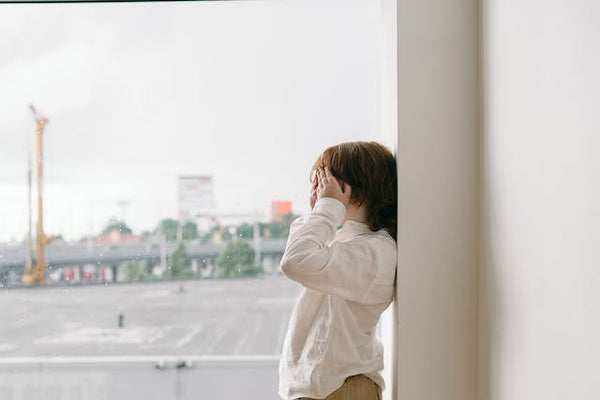Smart Tips for How to Manage Sensory Overload in Kids

Updated 27 Dec 2024
Kids thrive in an engaging setting that allows them to play and discover. That said, too much of a good thing can sometimes end up being problematic. Activities and noises that your child typically enjoys can sometimes become overwhelming, leading to sensory overload. Consequently, you may end up with a fussy baby, a tantrum-throwing toddler, or an irritable preschooler. Let’s take a closer look at sensory overload in children, how to identify when overstimulation is the issue, and a few ways to handle the situation.
What Is Sensory Overload?
Sensory overload, or overstimulation, occurs when children face an excess of experiences, sensations, sounds, and activities that surpass their capacity to handle. For instance, a newborn may cry after being surrounded by numerous unfamiliar adults at a family gathering. A preschooler might experience a meltdown following a particularly noisy social event. An older child may unravel if they go directly from school to after-school care and then to taekwondo class. With sensory overload, kids often feel overwhelmed and exhausted. They’re not trying to be disobedient – they simply need a break. Often the best remedy in these situations is some quiet time in a calm and familiar setting.
Unfortunately, it's easy to misinterpret these meltdowns as something else entirely, like willfully naughty behavior. That’s why it's crucial for parents to identify signs of overstimulation and learn their child’s ideal level of stimulation. While some children thrive with lots of activity, others require more quiet time. The key is to determine what balance works best for your child, ensuring a healthy mix of stimulation and downtime.

Recognizing Signs of Sensory Overload: How Do I Know If My Child Has Sensory Overload?
Children react differently to sensory input, with some having a very low tolerance for certain types of stimulation, leading to quicker negative responses. Overstimulated kids may exhibit heightened hyperactivity, aggression, or excitement, while others might withdraw, zone out, or appear sleepy. It's important to note that overstimulated children lack the coping mechanisms to handle their emotions and may not possess the communication skills to express their distress verbally. As a result, they may act out as their primary means of response. Recognizing signs of overstimulation in your child is essential, taking into account their age and developmental stage.
In babies
If your infant is overstimulated, you may observe the following behaviors:
- Clenching fists, waving arms, or kicking leg
- Increased and louder crying
- Heightened crankiness or fatigue
- Jerky movements
- Turning their head away from you
In toddlers or preschoolers
When a toddler or preschooler is experiencing sensory overload, it can be confused with the "terrible twos" or perceived as defiance. It's especially important to recognize the signs of overstimulation at this age. An overstimulated toddler or preschooler may:
- Cry extensively without being able to verbalize their feelings
- Resist simple tasks like putting on a seatbelt or picking up a dropped sippy cup
- Display signs of tiredness, grouchiness, and distress
- Throw themselves to the floor in tears or anger
In older children
Though it's simpler to recognize overstimulation in older children who can articulate their feelings, it's still good to know the signs at this age. Sensory overload for children at school or home might look like the following:
- Unusual behavior, such as acting differently or running around without a clear reason
- Behavior that deviates from their typical personality
- Signs of fatigue or sleepiness
- Aggressive or overly energetic behavior
- Outbursts, tantrums, or increased irritability
In children with autism
According to Autism Speaks, many children with autism exhibit specific behaviors in response to overstimulation. For autistic children, sensory overload may include the following:
- Increased physical activity, such as jumping, spinning, or crashing into objects
- Heightened stimming behaviors, like hand flapping, repetitive noises, or rocking
- Changes in speech patterns, talking faster and louder, or complete silence
- Covering ears or eyes in response to sensory stimuli
- Challenges in recognizing internal sensations like hunger, pain, or the need to use the bathroom
- Strong preferences or aversions to certain foods or clothing items
- Frequent non-food item chewing
- Excessive touching of others or engaging in rough play
- Communication difficulties or delayed responses as the brain prioritizes sensory input (shutdown)
- Escalating, overwhelming emotions or a strong need to escape a situation (meltdown)
Wind down with Tonies Tonies X Calm Audio Play Figurine. Together we bring little listeners mindfulness activities, breathwork meditations, and Sleep Stories™ to help them find their calm. You can also record your own mindfulness stories on this Tonie.

Tonies Tonies X Calm Audio Play Figurine
Helping an Overstimulated Child Unwind: How Do You Calm Down a Sensory Overload?
The trick to helping an overstimulated child calm down lies in understanding how they react to various sensory stimuli. Understanding what triggers them can help prevent sensory overload and mitigate disruptive behavior, particularly in babies and toddlers who haven't yet developed coping mechanisms.
As your children grow older, you can teach them coping strategies such as breathing techniques, taking a walk, lying down, or redirecting their focus to calming activities. For older kids, engaging in slow, steady resistance activities that require muscle exertion can help soothe their minds and calm their bodies. Here are a few tips to calm children when they are overstimulated.
In babies
When you observe signs of sensory overload in your baby, take them to a quiet space. If you're at home, take them to their room and dim the lights. If you're outside, consider placing the baby in a stroller with a light wrap or blanket, or swaddle them if they find it comforting. Carrying the baby close to your body in a sling or similar device can also provide soothing comfort, allowing you to carry on with your daily tasks while keeping your baby snug beside you.
In toddlers or preschoolers
When it comes to calming your toddler or preschooler, the first step is to keep yourself calm. Getting upset will only escalate your child's emotions, so take a deep breath and compose yourself before intervening. Next, reduce the surrounding noise or activity for your child. If you're at home, turn off the TV or radio, or take your child to a quieter space for activities like cuddling or reading together. Once your child is calm, allow them some time to play independently.
When your child is ready to reconnect, help them express their feelings verbally. Begin by acknowledging their emotional state, saying, "I could tell you were upset," and calmly inquire about what was bothering them. If your child mentions disliking a specific activity, delve into the reasons behind their feelings. Understanding their response provides valuable insights into your child's preferences and can help prevent future instances of overstimulation. If your child is exceptionally upset, you may need to postpone the discussion to a later, more suitable time.
In older children
Kids at this age are learning to self-soothe, but there are times when they might need your assistance. If you notice your child struggling with sensory overload, suggest they find a quiet place to rest. Reading or listening to soft music in a dimly lit room can be helpful, or they may simply want to cuddle up on the couch with you.
When discussing their feelings, acknowledge that you sense they are upset but are unsure of the cause. If they have difficulty expressing their emotions, gently help them identify and understand what they're feeling and why. It may also help to have a conversation with your child about their interests and priorities. Overstimulation may occur if they have too many commitments. Ensure they have sufficient time for homework, family time, socializing with friends, and personal downtime during the week. Avoid overscheduling to minimize the likelihood of dealing with overstimulation frequently.

In children with autism
Understanding and addressing sensory issues can improve the well-being of and improve learning and communication opportunities for children with autism. Accommodations may involve adjusting the environment, using new tools and strategies, or establishing new habits and routines. It's important to note that accommodations may need customization for different settings due to varying sensory needs.
According to Autism Speaks, examples of accommodations for hypersensitivity include using light covers or wearing sunglasses in fluorescent lighting, using ear plugs or headphones in noisy environments, working in enclosed spaces, avoiding strongly scented products, choosing foods with agreeable textures, temperatures, or spices, and wearing soft, comfortable clothing. Adjusting schedules to avoid crowds is also helpful. For hyposensitivity, accommodations may involve visual supports for processing spoken information, utilizing fidget toys and sensory tools, or arranging furniture to create safe, open spaces. It may mean taking frequent movement breaks, consuming foods with strong flavors or mixed textures, or using weighted blankets or clothing that provides deep pressure.
Meditation can also help with sensory overload in children with autism. Research has found mindfulness interventions to be beneficial for anger management, social communication, emotional well-being, and behavioral functioning.
Land of Dough Glitter Play Dough Roll is made of all-natural dough and colors, compostable glitters, and calming essential oils in eco-friendly packaging. The dough can air dry for keeping sculptures or refreshed for continued play with a damp paper towel and covered with a lid.

Land of Dough Glitter Play Dough Roll
The Takeaway on How You Treat Sensory Issues in Children
Determining the right amount of stimulation varies for each child, and there's no universal answer. Observe your child's reactions, and understand that moderation is crucial. Babies and young children should have dedicated time for quiet play or rest daily, while school-age children can benefit from one or two extracurricular activities aligned with their interests, such as sports, music lessons, or clubs, fostering social skills and friendships. However, excessive engagement in organized activities may deprive children of essential downtime for self-entertainment and relaxation. Striking a balance between appropriate stimulation and relaxation is the key.










